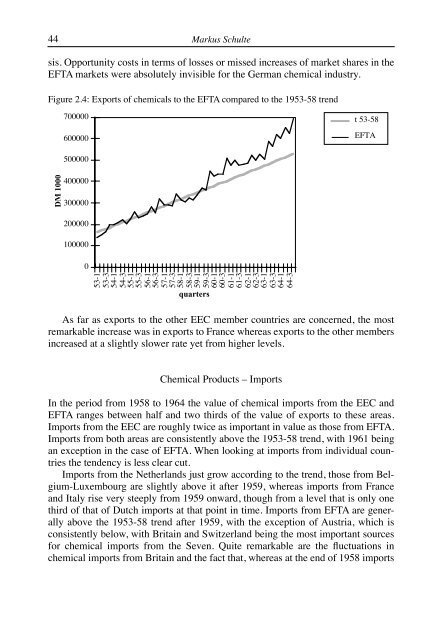Journal of European Integration History – Revue d'histoire de l'
Journal of European Integration History – Revue d'histoire de l'
Journal of European Integration History – Revue d'histoire de l'
- No tags were found...
You also want an ePaper? Increase the reach of your titles
YUMPU automatically turns print PDFs into web optimized ePapers that Google loves.
44Markus Schultesis. Opportunity costs in terms <strong>of</strong> losses or missed increases <strong>of</strong> market shares in theEFTA markets were absolutely invisible for the German chemical industry.Figure 2.4: Exports <strong>of</strong> chemicals to the EFTA compared to the 1953-58 trend700000600000t 53-58EFTA500000DM 1000400000300000200000100000053-153-354-154-355-155-356-156-357-157-358-158-359-159-360-160-361-161-362-162-363-163-364-164-3quartersAs far as exports to the other EEC member countries are concerned, the mostremarkable increase was in exports to France whereas exports to the other membersincreased at a slightly slower rate yet from higher levels.Chemical Products <strong>–</strong> ImportsIn the period from 1958 to 1964 the value <strong>of</strong> chemical imports from the EEC andEFTA ranges between half and two thirds <strong>of</strong> the value <strong>of</strong> exports to these areas.Imports from the EEC are roughly twice as important in value as those from EFTA.Imports from both areas are consistently above the 1953-58 trend, with 1961 beingan exception in the case <strong>of</strong> EFTA. When looking at imports from individual countriesthe ten<strong>de</strong>ncy is less clear cut.Imports from the Netherlands just grow according to the trend, those from Belgium-Luxembourgare slightly above it after 1959, whereas imports from Franceand Italy rise very steeply from 1959 onward, though from a level that is only onethird <strong>of</strong> that <strong>of</strong> Dutch imports at that point in time. Imports from EFTA are generallyabove the 1953-58 trend after 1959, with the exception <strong>of</strong> Austria, which isconsistently below, with Britain and Switzerland being the most important sourcesfor chemical imports from the Seven. Quite remarkable are the fluctuations inchemical imports from Britain and the fact that, whereas at the end <strong>of</strong> 1958 imports
















